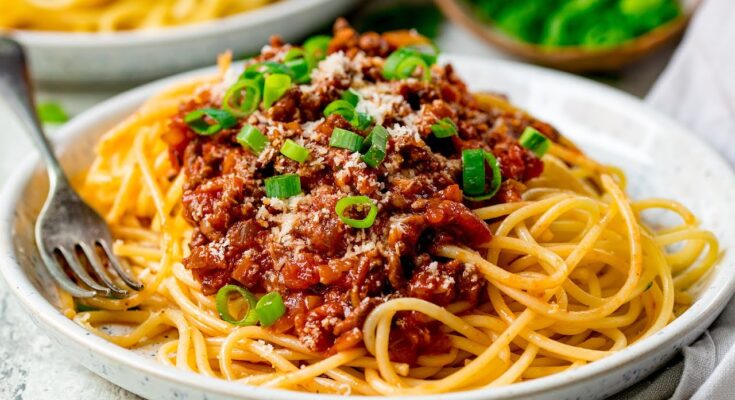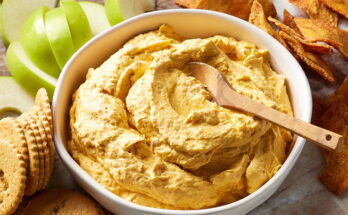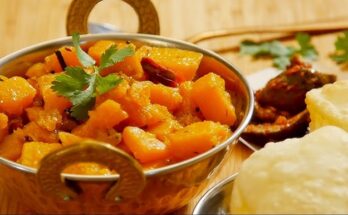Ragu Recipe: Ragu is more than just a pasta sauce—it’s a slow-cooked symphony of rich, savory flavors that has delighted food lovers for generations. It’s a hearty Italian meat sauce known for its deep, complex flavor profile, often featuring a blend of ground meat, aromatic vegetables, wine, and tomatoes simmered to perfection. Unlike quick sauces, ragu takes its time to develop, making every bite feel like a warm, comforting hug. It’s not flashy, but it doesn’t need to be—ragu speaks for itself through its bold yet balanced flavor.
While the term “ragu” can describe many types of meat sauces, in general, it stands out for its meaty texture and slow-cooked richness. This isn’t your average spaghetti sauce from a jar; this is homemade, kitchen-cooked, Sunday dinner-worthy ragu that tastes like it took all day—because it probably did.
Origins and Cultural Significance
The word “ragu” comes from the French word “ragout,” which means a stew of meat. Italy took that concept and turned it into something even more comforting. While different regions have their unique spins on ragu—such as the famed “Ragù alla Bolognese” from Bologna or Neapolitan versions with larger meat cuts—the core idea remains the same: a slow-cooked sauce brimming with depth and heartiness.
In Italian households, making ragu is a labor of love. It’s the kind of dish that brings families together, especially on Sundays or holidays. In many ways, it symbolizes tradition, patience, and home-cooked goodness. When you prepare ragu, you’re not just making dinner; you’re tapping into a time-honored ritual that has been passed down through generations.
Ingredients You’ll Need
Meat Choices for Ragu
The star of any ragu is the meat, and choosing the right one sets the tone for your entire sauce. Most traditional ragu recipes call for ground beef, pork, or a mix of the two. Some variations include veal or pancetta for an extra layer of richness. Here’s a breakdown of the best meat choices:
- Ground Beef (80/20): The fat content helps deliver a juicy and flavorful result.
- Ground Pork: Adds a slightly sweet, fatty richness that balances well with the acidity of tomatoes.
- Veal: Milder in flavor, perfect for lighter ragu.
- Pancetta or Italian Sausage (optional): Adds depth and smokiness.
Don’t be afraid to mix meats! A combo of beef and pork is often used to strike the perfect flavor balance. The meat should be fresh and ideally coarse-ground for the best texture.
Vegetables and Aromatics
The vegetable base is crucial for building flavor and creating a rich foundation. Known in Italian as “soffritto,” this trifecta of onions, carrots, and celery is sautéed gently to release sweetness and aroma.
- Onion: Adds sweetness and umami.
- Carrot: Provides natural sugar and a subtle earthy flavor.
- Celery: Brings a slight bitterness that balances everything out.
- Garlic (optional but recommended): For an extra kick of flavor.
Chop your vegetables finely for a smoother texture in the final sauce, and sauté them slowly in olive oil or butter until soft and fragrant.
Herbs, Spices, and Seasonings
These flavor enhancers take your ragu from good to unforgettable:
- Bay Leaves: Infuse the sauce with a gentle herbal note.
- Thyme and Rosemary: Offer an earthy, piney fragrance.
- Salt and Pepper: Essential for balancing flavors.
- Crushed Red Pepper Flakes (optional): Adds heat if you like a little spice.
Fresh herbs are preferred for their brightness, but dried versions work just fine in a pinch. Be sure to season in layers, tasting as you go.
Additional Ingredients That Add Depth
Great ragu isn’t just about meat and veggies—it’s about the depth of flavor. These additions make a big difference:
- Tomato Paste: Intensifies the tomato flavor and adds umami.
- Crushed Tomatoes or Passata: The base of the sauce; use high-quality for best results.
- Red or White Wine: Adds acidity and complexity (more on this later).
- Milk or Cream (optional): A splash at the end softens the sauce and balances acidity.
- Parmesan Rind (optional): Toss in while simmering for a cheesy, savory background note.
Kitchen Tools and Preparation Tips
Essential Utensils
You don’t need a fancy kitchen to make great ragu, but a few key tools can make the process smoother:
- Large Heavy-Bottomed Pot or Dutch Oven: Distributes heat evenly and holds up to long simmering.
- Wooden Spoon or Silicone Spatula: For stirring and scraping.
- Sharp Chef’s Knife: Makes chopping vegetables easier and more precise.
- Cutting Board and Measuring Cups: For prep work.
Investing in quality cookware, especially a heavy pot, pays off when you’re making a slow-simmered dish like ragu.
Prepping for the Perfect Ragu
Before you start cooking, get organized. Mis en place—French for “everything in its place”—is your best friend in the kitchen. Chop your vegetables, measure your liquids, and keep your spices within arm’s reach. Trust me, it makes the entire process less stressful and more enjoyable.
Also, allow your meat to come to room temperature before cooking. This helps it brown better, which equals more flavor. And if you’re using wine, pour yourself a glass—you deserve it.
Step-by-Step Instructions for Classic Ragu
Step 1: Sauté the Aromatics
This is where the flavor journey begins. Start by heating a generous glug of olive oil or a mix of olive oil and butter in your heavy-bottomed pot over medium heat. Once the oil shimmers, add your finely diced onions, carrots, and celery. Stir them gently and patiently; you want them to soften, not brown. This process should take around 10–15 minutes. It’s crucial not to rush this step. When done right, your kitchen will smell amazing—a savory, slightly sweet perfume that’s the first sign of great ragu.
Add a pinch of salt to help the vegetables release their moisture and become tender. If you’re a garlic lover, now’s the time to toss in a couple of minced cloves. Sauté just until fragrant, about 30 seconds, so it doesn’t burn. This is the solid flavor base—don’t skip it, don’t speed it up. You’re building the soul of the dish right here.
Step 2: Brown the Meat Properly
Once your aromatics are soft and fragrant, it’s time to bring in the meat. Push the vegetables to the sides of the pot and crank up the heat to medium-high. Add the ground meat in batches to avoid overcrowding the pan. When too much meat hits the pot at once, it steams instead of browning—and browning is where flavor lives.
As the meat hits the hot surface, let it sit for a minute or two without stirring to develop a nice crust. Then break it up with your spoon and continue cooking until all the pink is gone and you see lovely golden-brown bits starting to form. This is called the Maillard reaction, and it adds that deep, umami-packed flavor ragu is known for.
Drain excess fat if needed, but leave a little in the pot—it helps carry flavor through the sauce. At this point, you can also stir in finely chopped pancetta or Italian sausage if you’re using it. Give everything a good mix so the meat and vegetables are well combined and evenly cooked.
Step 3: Deglaze and Build the Base
Here’s where things start to smell and taste incredible. Once the meat is nicely browned and integrated with the aromatics, it’s time to deglaze. Pour in your wine (red for richness, white for brightness—both work wonderfully). Scrape the bottom of the pot with your spoon to loosen all the flavorful bits stuck there—this is flavor gold.
Let the wine simmer and reduce by half. This burns off the alcohol and concentrates the flavor. You’ll notice the aroma getting deeper and more complex.
Now, stir in a couple of tablespoons of tomato paste. Cook it for 2–3 minutes to “wake it up”—this caramelizes the sugars and brings out its richness. Then, add your crushed tomatoes or passata and stir to combine.
Add bay leaves and any other herbs you like—thyme, rosemary, even a little oregano. Taste and season with salt and pepper, remembering you can always add more later.
Step 4: Simmer Low and Slow
This is the magic step, the one that transforms simple ingredients into a masterpiece. Once everything’s in the pot, reduce the heat to the lowest setting possible. Cover the pot partially (leave a bit of room for steam to escape) and let the sauce simmer gently for at least 1.5 to 2 hours—longer if you can.
Stir occasionally and check to make sure nothing is sticking to the bottom. Add a splash of water, stock, or milk if the sauce seems too thick. Over time, the sauce will reduce and thicken, and the flavors will meld into something comforting and complex.
If you’ve got a Parmesan rind, now’s the time to throw it in. It melts slowly and adds a cheesy umami richness you can’t get from seasoning alone. A small splash of milk or cream near the end of cooking rounds everything out and softens the acidity of the tomatoes.
By the end, your kitchen will smell divine, and your sauce will look thick, deep red, and rich. Taste it, adjust the seasoning, and get ready to serve.
Step 5: Final Seasoning and Serving Tips
Before you serve, give your ragu a final taste. Add salt, pepper, or even a touch of sugar if the tomatoes were a bit too acidic. Remove any herb stems or bay leaves, and if you added a Parmesan rind, fish it out as well.
You can serve your ragu immediately, but it actually tastes even better the next day after the flavors have had time to deepen overnight in the fridge. Don’t forget to cook your pasta just before serving and always toss it directly with the sauce rather than serving it on top—this helps the pasta soak up the rich flavors.
Top with freshly grated Parmigiano-Reggiano, a drizzle of good olive oil, and maybe a sprinkle of fresh basil or parsley for color and brightness.
Serving Suggestions and Pairings
Best Pasta Types for Ragu
Ragu is a rich, meaty sauce, so it pairs best with hearty, textured pastas that can stand up to its weight and soak up every bit of its deliciousness. Choosing the right pasta shape isn’t just about tradition—it’s about engineering the perfect bite. Here are some pasta options that pair like a dream with ragu:
- Tagliatelle: The most traditional pairing, especially with Bolognese. These flat, ribbon-like noodles cradle the sauce beautifully.
- Pappardelle: Even wider than tagliatelle, this pasta is perfect for ultra-rich, chunky ragus.
- Fettuccine: Another flat noodle that works well with thick sauces, slightly thinner than tagliatelle.
- Rigatoni: The ridges and tubes trap the sauce inside and out, giving each bite full flavor.
- Gnocchi: Soft, pillowy gnocchi soak up the sauce and add a delightful contrast in texture.
Avoid lighter pastas like angel hair or capellini—they’ll get overwhelmed by the sauce and break apart easily. Always cook your pasta al dente and toss it directly into the sauce to let it absorb the flavors. Finish cooking it in the sauce with a bit of reserved pasta water to help it cling perfectly.
Wine Pairings and Side Dishes
Ragu and wine? A match made in culinary heaven. Since ragu is bold and savory, it pairs best with equally robust red wines. A good wine doesn’t just complement the meal—it elevates it.
Top Wine Pairings:
- Chianti Classico: With its acidity and earthy notes, it balances the richness of the meat.
- Barolo or Barbaresco: These bold, tannic wines from Northern Italy are perfect for deep, complex ragus.
- Montepulciano d’Abruzzo or Sangiovese: Fruit-forward yet structured wines that work well with tomato-based sauces.
- Cabernet Sauvignon or Zinfandel: If you prefer New World wines, go for these full-bodied reds.
For sides, keep it simple and rustic:
- Garlic Bread or Rustic Italian Loaf: Perfect for scooping up the last bits of sauce.
- Simple Green Salad with Balsamic Vinaigrette: Cuts through the richness with acidity and crunch.
- Roasted Vegetables: Carrots, zucchini, and bell peppers make a colorful and healthy side.
- Polenta or Mashed Potatoes (for a twist): Excellent for soaking up sauce if you’re skipping pasta.
A classic Italian meal is about balance—rich main, simple sides, and always room for wine and good conversation.
FAQs about Ragu Recipe
Q1. What is the difference between Ragu and Bolognese?
While both are meat-based Italian sauces, Ragu is a broader term that refers to any meat sauce, often with tomatoes. Bolognese is a specific type of Ragu from Bologna that includes milk or cream and has a richer, thicker texture.
Q2. Can I use ground turkey or chicken instead of beef?
Yes! Ground turkey or chicken can be used for a lighter version of Ragu. Just note that the flavor will be milder than traditional beef or pork Ragu.
Q3. How long should I cook Ragu?
Ragu is best when slow-cooked for at least 1.5 to 2 hours. This allows the flavors to develop deeply and the meat to become tender and rich.
Q4. Can I make Ragu ahead of time?
Absolutely! In fact, Ragu tastes even better the next day. Store it in the fridge for up to 3 days or freeze for up to 3 months.
Q5. What pasta goes best with Ragu?
Thick, hearty pastas like pappardelle, tagliatelle, or rigatoni are ideal. Their texture holds up well and soaks up the meaty sauce beautifully.
Q6. Can I make Ragu in a slow cooker?
Yes, Ragu is perfect for the slow cooker. Sauté your ingredients first, then let it simmer on low for 6–8 hours for maximum flavor.
Conclusion
Making ragu is more than just following a recipe—it’s a culinary ritual. It takes patience, attention, and a little love, but the result is worth every minute. This sauce is the embodiment of comfort, tradition, and flavor. It’s what Sunday dinners were made for, what family recipes are built around, and what makes even a quiet evening feel like something special.
Whether you’re crafting a classic Bolognese, a hearty Neapolitan-style ragu, or your own family version, the essence remains the same—slow-cooked richness that brings people together. The beauty of ragu lies in its adaptability; you can tweak the ingredients, meat combos, or even cooking times based on your tastes and still end up with something delicious.
Next time you’re in the mood for something truly soul-warming, remember this ragu recipe. It’s not just food—it’s tradition on a plate. And once you make it from scratch, you might never go back to store-bought sauce again.



